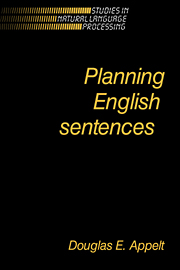Book contents
- Frontmatter
- Contents
- Dedication
- Preface
- 1 Introduction
- 2 An overview of related research
- 3 Representing knowledge about intensional concepts
- 4 Planning to affect an agent's mental state
- 5 Planning illocutionary acts
- 6 Planning surface linguistic acts
- 7 Utterance planning: an example
- 8 Utterance planning: the future
- Notes
- Bibliography
5 - Planning illocutionary acts
Published online by Cambridge University Press: 03 December 2009
- Frontmatter
- Contents
- Dedication
- Preface
- 1 Introduction
- 2 An overview of related research
- 3 Representing knowledge about intensional concepts
- 4 Planning to affect an agent's mental state
- 5 Planning illocutionary acts
- 6 Planning surface linguistic acts
- 7 Utterance planning: an example
- 8 Utterance planning: the future
- Notes
- Bibliography
Summary
What is a speech act?
Speech act theory has its roots in the work of Wittgenstein, who in Philosophical Investigations proposed an analogy between using language and playing games. His basic point was that language is a form of rule-governed behavior, much the same as game-playing, employing rules and conventions that are mutually known to all the participants.
The field of speech act theory is usually considered to have been founded by Austin (1962) who analyzed certain utterances called performatives. He observed that some utterances do more than express something that is true about the world. In uttering a sentence like “I promise to take out the garbage,” the speaker is not saying anything about the world, but is rather undertaking an obligation. An utterance like “I now pronounce you man and wife” not only does not say anything that is true about the world, but when uttered in an appropriate context by an appropriate speaker, actually changes the state of the world. Austin argued that an account of performative utterances required an extension of traditional truth-theoretic semantics.
The most significant contribution to speech act theory has been made by philosopher John Searle (1969, 1979a, 1979b), who was the first to develop an extensive formulation of the theory of speech acts.
- Type
- Chapter
- Information
- Planning English Sentences , pp. 83 - 98Publisher: Cambridge University PressPrint publication year: 1985



